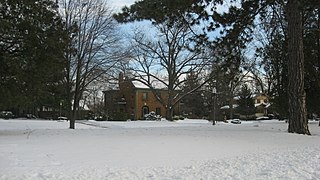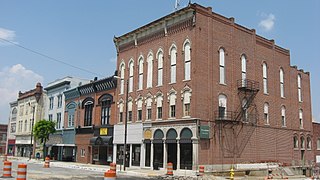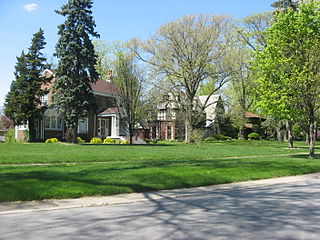
The Williams–Woodland Park Local Historic District was established in 1985 and is a national historic district located at Fort Wayne, Indiana. The district encompasses 287 contributing buildings in a predominantly residential section of Fort Wayne located approximately one mile south of downtown. The area was developed from about 1875 to 1940, and includes notable examples of Colonial Revival, Prairie School, and Queen Anne style residential architecture.

The Forest Park Boulevard Historic District is a national historic district located at Fort Wayne, Indiana. The district encompasses 93 contributing buildings, 1 contributing site, and 15 contributing objects in a predominantly residential section of Fort Wayne. The area was developed from about 1890 to 1955, and includes notable examples of Colonial Revival and Tudor Revival style architecture. The district features ornamental light posts / streetlights and stone entry markers.

Hope Historic District is a 114-acre (46 ha) national historic district located at Hope, Bartholomew County, Indiana. It encompasses 205 contributing buildings, four contributing sites and two contributing objects in the central business district and surrounding residential areas of Hope. It was developed between about 1840 and 1940, includes works by architect Elmer E. Dunlap and by L.W. Weisner, and notable examples of Greek Revival, Italianate, Hall and parlor, and other architecture. Notable buildings include the Moravian Church (1875) and old parsonage (1875), City School (1906), Baptist Church, Methodist Episcopal Church (1887), Alfred Sanford Rominger House, Frank Stapp House, Masonic Temple (1910), and E.B. Spaugh Building (1915).

Southwood Park Historic District is a national historic district located at Fort Wayne, Indiana. The district encompasses 1,889 contributing buildings, 1 contributing site, 4 contributing structures, and 1 contributing object in a predominantly residential section of Fort Wayne. The area was developed between about 1906 and 1965, and includes notable examples of Colonial Revival, Tudor Revival, Mission Revival, and Bungalow / American Craftsman style residential architecture. Its development is directly related to the implementation of the 1912 plan for Parks and Boulevards for the city of Fort Wayne by city planner and landscape architect George Kessler.

South Wayne Historic District is a national historic district located at Fort Wayne, Indiana. The district encompasses 133 contributing buildings and 1 contributing structure in a predominantly residential section of Fort Wayne. The area was developed between about 1893 and 1940, and includes notable examples of Colonial Revival, American Four Square, and Bungalow / American Craftsman style residential architecture.

Point Historic District is a national historic district located at Logansport, Cass County, Indiana. The district encompasses 34 contributing buildings, 2 contributing sites, and 1 contributing structure in the heart of the oldest section of Logansport. It has a mix of residential and commercial buildings and notable examples of Queen Anne and Colonial Revival style residential architecture. Notable contributing resources include the Urban Point Park, Firestone Station (1928), All Saints Rectory, St. Joseph's Roman Catholic Church (1884), Geiger Building (1889), and St. Luke's English Evangelical Lutheran Church (1908).

Meridian–Forest Historic District is a national historic district located at Brazil, Clay County, Indiana. The district encompasses 220 contributing buildings and 13 contributing structures in a predominantly residential section of Brazil. The district developed between about 1866 and 1940, and includes notable examples of Italianate, Romanesque Revival, and Queen Anne style architecture. The district is characterized by brick streets and alleys. Notable buildings include the First Methodist Church, First Presbyterian Church, Masonic Lodge, Carnegie Library, and Brazil Junior High School.

Frankfort Commercial Historic District is a national historic district located at Frankfort, Clinton County, Indiana. The district encompasses 57 contributing buildings and 6 contributing structures in the central business district of Frankfort. The district developed between about 1870 and 1947, and includes notable examples of Italianate, Romanesque Revival, and Classical Revival style architecture. Located at the center of the district is the separately listed Clinton County Courthouse. Other notable buildings include the Harker Building (1890), Frankfort Municipal Building (1916), Coca-Cola building (mid-1920s), Ross Building (1897), Keys Building (1899), and K. F. & W Traction Station.

Christian Ridge Historic District is a national historic district located at Frankfort, Clinton County, Indiana. The district encompasses 430 contributing buildings and 2 contributing structures in a predominantly residential section of Frankfort. The district developed between about 1832 and 1952, and includes notable examples of Queen Anne, Colonial Revival, and Bungalow / American Craftsman style residential architecture. Located in the district is the separately listed Old Frankfort Stone High School.

The Georgetown Historic District is a national historic district located at Georgetown, Floyd County, Indiana. The district encompasses 163 contributing buildings, 1 contributing site, and 3 contributing structures in the central business district and surrounding residential sections of Georgetown. It developed between about 1835 and the 1950s, and includes notable examples of Greek Revival, Italianate, Classical Revival, Bungalow / American Craftsman, and Ranch style architecture. Notable buildings include the Georgetown Township Consolidated School (1925), Georgetown Firehouse, Wolfe Hotel (1835), Georgetown Bank (1909), First United Brethren Church (1843), Sherman Minton Birthplace (1858), and George R. Fox Saloon.

Attica Main Street Historic District is a national historic district located at Attica, Fountain County, Indiana. The district encompasses 36 contributing buildings, 1 contributing site, and 2 contributing structures in a predominantly residential section of Attica. It developed between about 1840 and 1940, and includes notable examples of Late Victorian, Greek Revival, and Federal style architecture. Located in the district is the separately listed Marshall M. Milford House. Other notable contributing resources include McDonald Park, Parker-Clark House, Attica Presbyterian Church (1849), Ziegler House, Rolphing-Colvert Home, "Ladies Library" (1889), former Church of Christ (1891), and Attica Methodist Church (1921).

South 9th Street Historic District is a national historic district located at Noblesville, Hamilton County, Indiana. It encompasses 39 contributing buildings and 1 contributing site in a predominantly residential section of Noblesville. It developed between about 1860 and 1940, and includes notable examples of Queen Anne, Italianate, and Bungalow / American Craftsman style architecture. Notable buildings include the Masonic Temple and Adler Building.

Forest–Southview Residential Historic District is a national historic district located at Hammond, Lake County, Indiana. The district encompasses 39 contributing buildings and 1 contributing site in an exclusively residential section of Hammond. It developed between about 1912 and 1949, and includes notable example of Renaissance Revival, Colonial Revival, Tudor Revival, and Bungalow / American Craftsman styles of residential architecture.

Indi-Illi Park Historic District is a national historic district located at Hammond, Lake County, Indiana. The district encompasses 93 contributing buildings in an exclusively residential section of Hammond. It developed between about 1923 and 1940, and includes notable example of Colonial Revival, Tudor Revival, Classical Revival, Bungalow / American Craftsman, and eclectic styles of residential architecture.

East Washington Street Historic District is a national historic district located at Martinsville, Morgan County, Indiana. The district encompasses 64 contributing buildings, 1 contributing site, and 7 contributing structures in a predominantly residential section of Martinsville. It developed between about 1869 and 1940, and includes notable examples of Queen Anne, Classical Revival, and Colonial Revival style architecture. Located in the district is the separately listed Neely House. Other notable buildings include the Martinsville Presbyterian Church, Sweet House, Gum House, Hubbard-Gano House, Frank Oak Branch House (1916), and Francesconi House.

Paoli Historic District is a national historic district located at Paoli, Orange County, Indiana. The district encompasses 144 contributing buildings, 1 contributing site, 4 contributing structures, and 4 contributing objects in the central business district and surrounding residential sections of Paoli. It developed between about 1840 and 1940, and includes notable examples of Greek Revival, Italianate, and Queen Anne style architecture. Located in the district are the separately listed Thomas Newby Braxtan House and Orange County Courthouse. Other notable contributing resources include Lithia Springs Park, Dr. J.H. Sherrod House (1885), Gabbert House, Lithia Water Bottling Plant (1920), Orange County Jail (1858), U.S. Post Office (1937), Presbyterian Church (1920), Methodist Episcopal Church (1888), Braxtan Store, Riley Building (1887), Paoli State Bank (1912), and Thomas Volney Thornton House (1846).

Winchester Residential Historic District is a national historic district located at Winchester, Randolph County, Indiana. The district encompasses 142 contributing buildings, 1 contributing site, and 1 contributing structure in a predominantly residential section of Winchester. The district developed between about 1837 and 1950 and includes notable examples of Greek Revival, Italianate, Romanesque Revival, Colonial Revival, Prairie School, and Classical Revival style architecture. Notable buildings include the First Presbyterian Church of Winchester (1903), Winchester Friends Church (1897), First United Methodist Church (1900), Main Street Christian Church (1912), First Church of the Nazarene (1929), Carey Goodrich House (1858), Kizer-Marsh House, and W.E. Miller House (1910).

Hills and Dales Historic District is a national historic district located at West Lafayette, Tippecanoe County, Indiana. The district encompasses 136 contributing buildings and 39 noncontributing buildings in a predominantly residential section of Lafayette, platted in 1922–1924. It developed between about 1911 and 1951 and includes representative examples of Colonial Revival, Tudor Revival, French Renaissance, and Ranch style architecture. Notable contributing buildings include the Haniford House, Herbert Graves House,, and Marion J. Eaton House.

Brendonwood Historic District, also known as Brendonwood Common, is a national historic district located at Indianapolis, Indiana. It encompasses 85 contributing buildings, 2 contributing sites, and 1 contributing object in a planned suburban residential section of Indianapolis. 350 acres on the eastern edge of Millersville with Fall Creek as the western boundary was the vision of Charles S. Lewis for a self-regulated residential zone of 110 plots. Noted landscape architect George E. Kessler was hired to develop the planned community. The district developed between about 1917 and 1954, and includes representative examples of Tudor Revival, Colonial Revival, and Bungalow / American Craftsman style architecture. Notable contributing resources include the Common House (1924), golf course, Two Knolls (1951-1952), Farlook (1939), Springhead (1934), Dearwald (1927), Wancroft (1940), Larkwing (1952), Grasmere (1937-1938), Wetermain (1921), Whispering Trees (1952-1953), Glen Gate (1922-1923), Witching View (1928-1929), Long Ridge (1923-1924) and Great Maple (1948).

Ransom Place Historic District is a national historic district located at Indianapolis, Indiana. The district encompasses 74 contributing buildings in a historically African-American residential section of Indianapolis. It was developed between about 1890 and 1942, and include representative examples of Queen Anne style architecture. Notable buildings include the Light of the World Christian Church (1910).
























